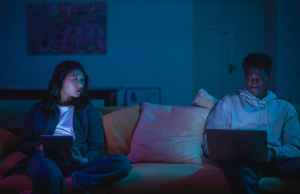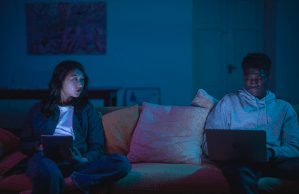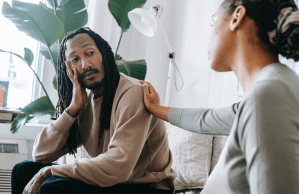An abusive relationship can consist of several traumatic events, which can cause these symptoms to stay present during the relationship as well as long after the relationship has ended. In the first month following a traumatic experience, if these symptoms are present, it is considered to be an acute stress reaction, and after one month, it can be diagnosed as post-traumatic stress disorder (PTSD).
Experiences from an abusive relationship, whether or not it involved physical abuse, can lead to post-traumatic stress disorder. To understand why this is, it is first important to understand what trauma does to the brain and how it can impact one’s mental and physical well-being.

What Is Relationship PTSD?
Relationship PTSD is a type of traumatic response that usually develops from experiencing abuse, trauma, or interaction(s) with a partner/relationship who is unhealthy. These experiences can then cause further complications with one’s ability to healthily maintain and engage in interpersonal relationships (romantic or platonic) throughout their life if left untreated.
While relationship PTSD is not a clinically diagnosable disorder according to the Diagnostic and Statistical Manual of Mental Disorders, Fifth Edition (DSM-5), you can absolutely develop post-traumatic stress disorder (PTSD) from abuse or trauma experienced within an interpersonal relationship.
Symptoms can include but are not limited to:
- Feelings of hypervigilance
- Avoidant behaviors
- Feeling chronically unsafe
- Difficulty trusting others
- Anxiety
- Depression
- Self-sabotaging behaviors
Impact of PTSD on Relationship Dynamics
Relationship PTSD can and does have a significant impact on an individual and relationship dynamics, but that impact is very specific to the individual who is experiencing PTSD and the nature of their relationship. In some instances, it can damage or reduce emotional and physical intimacy, cause feelings of distance, or it can cause difficulties in communication.
Due to the avoidant behavior responses that relationship PTSD can cause, it can make those experiencing it feel isolated and trapped, which can then lead to feelings of frustration and a perceived lack of respect from their partner. The negative patterns and behaviors that can develop due to relationship PTSD often create a barrier to healthy bidirectional communication of personal wants and needs.
When someone is experiencing this kind of emotional distress, the brain can’t really process information effectively because of an overactivation of stress hormones causing a “fight, flight, or freeze” response. When the mind senses physical or emotional danger, the body instinctively takes some kind of protective action, such as running away or withdrawing emotionally. After experiencing emotional manipulation, threatening behavior, or physical violence, one’s brain may not be able to distinguish similar, non-threatening behavior from past events, causing a trauma response to be triggered.
The Emotional Toll of Relationship PTSD on Intimacy
Relationship PTSD, especially if left untreated, has a high likelihood of creating difficulties in maintaining emotional and physical levels of intimacy within interpersonal relationships.
This can take many forms—as described above, the sufferer typically experiences avoidant behavior patterns surrounding their triggers, so they can seem disengaged or disinterested in their relationship when in reality, they might not be.
Relationship PTSD is a very complicated and intense mental condition, and though it’s no fault of the person who has it, it can place a heavy emotional burden on all involved and can lead to an increased risk of emotional burnout.
Effective Communication Strategies for Couples
Effective communication strategies for couples involve the use of clear, direct communication of personal wants and needs as well as communication of how the behaviors of their partner impact them.
The use of “I messages” is always widely recommended, as they’re a great way to express your feelings with your partner while avoiding blaming or shaming language. An “I message” consists of phrases like “I felt (insert emotion) when you (insert behavior),” putting the emphasis on the feelings of the speaker and not as much the actions of the partner. This serves as a way to educate and bring insight to your partner without making them feel as if you’re directly criticizing them.
Other effective communication strategies simply involve making sure you’re regularly taking time to check in with your partner about the state of your relationship, each other, and your personal wants and needs. Try carving out five minutes daily to have a conversation and ask them how they’re doing, what you can do to support them, and if there’s anything that you can do to be helpful to them that day. It seems simple, but it can be a very effective tool for maintaining a healthy relationship.
How to Build Resilience as a Couple
The best way to build resilience as a couple is to attend couples counseling sessions. In these sessions, you’ll be paired with a professional who is able to recommend treatment interventions that are tailored to each of your specific needs.
Outside of therapy, another great way to build resiliency as a couple is to make sure you’re communicating through conflict instead of shutting down or avoiding it. It can feel difficult to do at times, but the only way to build resiliency as a couple is by effectively navigating conflict, difficult emotions, and seemingly un-survivable emotional situations.
The best way to do this is to view your conflict and relationship through the lens of “you & your partner vs. the problem”, not “you vs. your partner vs. the problem.” The more you’re both able to feel as though you’re on the same team and you are fully supported no matter what you’re navigating, the higher your resilience will be as a couple.
How to Cope With Relationship PTSD
Having clear, healthy forms of communication is one of the most effective, evidence-based ways to cope with relationship PTSD, both for the person with it as well as the partner. Being able to communicate how you’re feeling in a relationship using clear, objective, non-blaming communication styles is incredibly helpful and important. It will help you get your needs met as well as reduce the development of any potential resentment.
Another great way to cope with relationship PTSD is to educate yourself about it. Whether you’re the sufferer or the partner, try engaging in evidence-based literature, joining a support group, or learning more about PTSD and the neural mechanisms behind it. Education is key to understanding, and while it does not offer an excuse for negative or unhealthy behavior, finding an explanation for these behaviors within oneself or one’s partner is key to dealing with them effectively, and can help to keep things objective and non-personal within the relationship.
What Kind of Therapy Techniques Can Treat Relationship PTSD?
There are many ways to heal from relationship PTSD, and it’s important to know that you don’t have to do it alone. One of the best ways to find help and healing is to seek counseling to work through symptoms you may be experiencing that are interfering with your daily life. Relationship PTSD can be treated in both individual and couples counseling settings, and in fact, it’s recommended that both be included in treatment if you’re able.
In individual therapy settings, your therapist will likely utilize cognitive behavioral therapy (CBT), mindfulness, dialectical behavior therapy (DBT), and/or cognitive processing therapy (CPT) techniques to help you gain insight into your PTSD as well as find tools to successfully manage and overcome triggers.
One of the most common trauma-specific treatment models is eye movement desensitization and reprocessing (EMDR). EMDR is a heavily researched, proven-effective technique that helps patients reprocess painful memories to reduce emotional distress when remembering the traumatic event(s). With help from a trained and licensed therapist or counselor, an individual can start down the road to recovering from relationship PTSD.
In couples counseling settings, your therapist will probably utilize CBT, emotionally focused strategies, mindfulness training, and attachment theory to help you build resiliency as a couple. There is some overlap between the modalities used in individual therapy as well, but the overall goal for relationship PTSD treatment is to increase overall resiliency through increasing distress tolerance, increasing personal insight, increasing personal regulation capacities, and increasing the ability to discuss and communicate effectively.
If you are struggling to maintain healthy, productive relationships with others or see some of the above symptoms affecting your daily life, consider getting in touch with a mental health professional. They can help you process what’s happening and give you tools to effectively manage your symptoms, allowing you to live the life you want.













